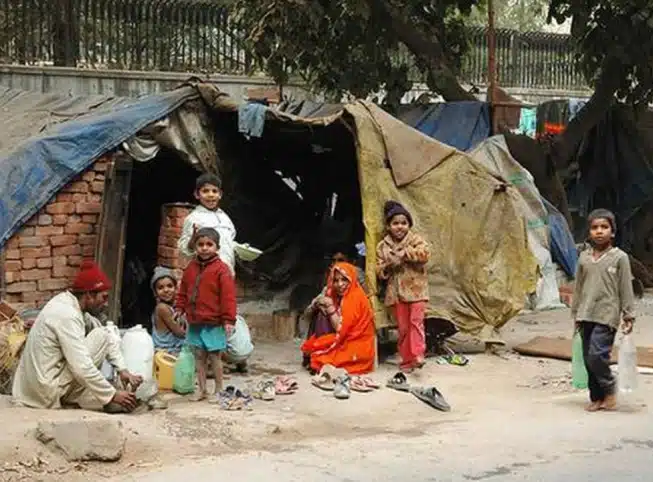What’s in Today’s Article?
- Why in news?
- What is Multidimensional Poverty?
- What is National Multidimensional Poverty Index (MPI)?
- MPI Parameters & Methodology:
- News Summary: NITI Aayog’s Discussion Paper – Multidimensional Poverty in India since 2005-06
- Key highlights of the report
Why in news?
- As per the NITI Aayog’s Discussion Paper ‘Multidimensional Poverty in India since 2005-06’, 24.82 crore people escaped multidimensional poverty in last nine years.
- The National Multidimensional Poverty Index (MPI) by Niti Aayog measure the multidimensional poverty in India.
Multidimensional Poverty
- A person who is poor can suffer multiple disadvantages at the same time – for example they may have poor health or malnutrition, a lack of clean water or electricity, poor quality of work or little schooling.
- Focusing on one factor alone, such as income, is not enough to capture the true reality of poverty.
- Multidimensional Poverty is a measure of poverty that captures deprivations in education and access to basic infrastructure in addition to income or consumption at the $2.15 international poverty line (as per World Bank).
- World Bank defines the international poverty line at USD 2.15 (in 2017 purchasing power parity terms) daily to measure monetary value.
National Multidimensional Poverty Index (MPI)
- MPI has been used by the United Nations Development Programme (UNDP) in its flagship Human Development Report since 2010.
- In this context, NITI Aayog had published the first edition of national Multidimensional Poverty Index for India in 2021.
- Purpose –
- A national MPI statistic for a country is tailored to the national priorities and therefore, countries choose their own set of dimensions, indicators, weights, and cut-offs, according to their plans and contexts.
- The report presents an in-depth analysis of the headcount ratio and intensity of multidimensional poverty at the national, State/UT, and district levels.
- The first report was based on the reference period of 2015-16 of the National Family Health Survey (NFHS)- 4.
MPI Parameters & Methodology
- The Index is based on the Alkire-Foster (AF) methodology and has three equally weighted dimensions –
- These three dimensions are represented by 12 indicators as given in the fig:
- The index is calculated by first setting the deprivation cut-offs for each indicator, i.e., the level of achievement considered normatively sufficient for an individual to be considered not deprived in an indicator.
- For example, the individual has completed at least six years of schooling. Such a cut off would be applied to determine whether the individual is deprived in each indicator.
- Weights are attached to each indicator and a composite metric is then used to calculate the index.
News Summary: NITI Aayog’s Discussion Paper – Multidimensional Poverty in India since 2005-06
Key highlights of the report
- Significant decline in multidimensional poverty in India
- From 29.17% in 2013-14 to 11.28% in 2022-23 i.e. a reduction of 17.89 percentage points.
- States with largest decline
- Uttar Pradesh topped the list with 5.94 crore people escaping poverty followed by Bihar at 3.77 crore and Madhya Pradesh at 2.30 crore.
- India likely to achieve SDG Target 1.2 (reducing multidimensional poverty by at least half) well before 2030.
- Government’s goal
- Government has a goal to bring down multidimensional poverty to below 1% and all efforts are being made in that direction.
- The report said India is all set to reach single-digit poverty levels during 2024.
- Report highlighted noteworthy initiatives
- Initiatives like Poshan Abhiyan and Anemia Mukt Bharat have significantly enhanced access to healthcare facilities, leading to a substantial decrease in deprivation.
- Operating one of the world’s largest food security programs, the targeted public distribution system (PDS) under the National Food Security Act covers 81.35 crore beneficiaries, providing food grains to rural and urban populations.
Q1) What is Target 1.2 of the Sustainable Development Goals (SDGs)?
Target 1.2 of the Sustainable Development Goals (SDGs) is to reduce poverty by at least 50% by 2030. This target applies to men, women, and children of all ages, and is based on regional definitions.
Q2) What is the main aim of NITI Aayog?
To evolve a shared vision of national development priorities, sectors and strategies with the active involvement of States. To ensure, on areas that are specifically referred to it, that the interests of national security are incorporated in economic strategy and policy.
Source: Over 24.8 crore people moved out of poverty in India in nine years: NITI report | PIB | NITI Aayog
Last updated on June, 2025
→ UPSC Notification 2025 was released on 22nd January 2025.
→ UPSC Prelims Result 2025 is out now for the CSE held on 25 May 2025.
→ UPSC Prelims Question Paper 2025 and Unofficial Prelims Answer Key 2025 are available now.
→ UPSC Calendar 2026 is released on 15th May, 2025.
→ The UPSC Vacancy 2025 were released 1129, out of which 979 were for UPSC CSE and remaining 150 are for UPSC IFoS.
→ UPSC Mains 2025 will be conducted on 22nd August 2025.
→ UPSC Prelims 2026 will be conducted on 24th May, 2026 & UPSC Mains 2026 will be conducted on 21st August 2026.
→ The UPSC Selection Process is of 3 stages-Prelims, Mains and Interview.
→ UPSC Result 2024 is released with latest UPSC Marksheet 2024. Check Now!
→ UPSC Toppers List 2024 is released now. Shakti Dubey is UPSC AIR 1 2024 Topper.
→ Also check Best IAS Coaching in Delhi


























